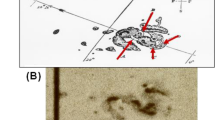Abstract
IN a series of recent mathematical papers, culminating in a general review of the subject in more physical terms1, S. Chandrasekhar has laid the foundations of a statistical theory of stellar dynamics which treats the subject in a way fundamentally different from the ordinary analytical approach. Certain aspects of the theory concerning the dynamics of star clusters and the statistics of binary stars are discussed in detail by Chandrasekhar; they have interesting repercussions on current ideas concerning the time-scale of the universe, and are summarized below.
Similar content being viewed by others
References
Ann. New York Acad. Sci., 45, 131 (1943).
Astrophys. J., 97, 255 (1943).
Astrophys. J., 98, 54 (1943).
Science, 99, 133 (1944).
Nature, 137, 537 (1936).
Astrophys. J., 99, 54 (1944).
Nature, 149, 235 (1942).
Observatory, 65, 211 (1944).
Rights and permissions
About this article
Cite this article
HUNTER, A. The Cosmic Time-Scale. Nature 154, 327–328 (1944). https://doi.org/10.1038/154327a0
Issue Date:
DOI: https://doi.org/10.1038/154327a0
- Springer Nature Limited





